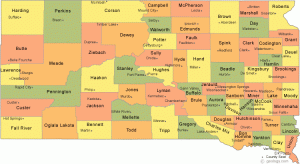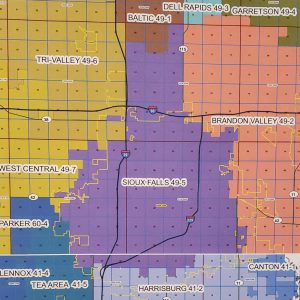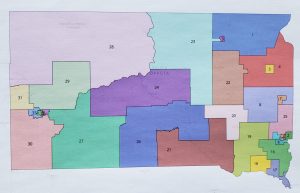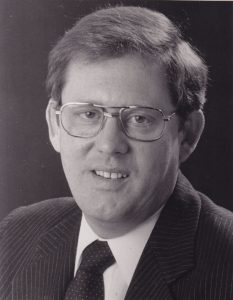We like to think our state is a great example of small, conservative government at its best, with minimal wasteful spending. But I suspect we may be fooling ourselves. By historical accident, we now have too many governments in South Dakota. And they aren’t laid out in a way that makes sense today.
Population Growth Was Expected
South Dakota was expected to be a well-populated, rural state just like the states east of the Dakotas. At least that is what early leaders and promoters assumed as they created an extensive statewide system of local governments to serve all those rural citizens.
They blanketed the state with 66 counties, each designed so that the county seat would be a day’s horse ride away. They also created an extensive network of cities, towns, townships, villages and school districts.

For a while, it looked like they might be right. At the beginning of the 20th century 90% of South Dakotans lived in rural areas. But over the following decades, the total population of the state stagnated as the rural numbers decreased. In 2010 only 43% lived in rural areas. And according to the US Census Bureau, most South Dakota residents now live in urban areas.
Rural Populations Evaporated
The world changed in the 20th century. Innovations in communication, transportation and especially agriculture altered the way we all live, and where we live.
The population of several South Dakota counties evaporated. In 2010, 11 met the traditional Census Bureau designation of “unsettled” or frontier territory having two or fewer persons per square mile. Five more have fewer than three and they are continuing to lose residents.
South Dakota leads the nation in the number of counties with a population of under 5,000. It also has the nation’s poorest county, Buffalo, and its smallest county seat, Gann Valley, with a 2010 census count of 14.
Urban Areas Grew and Spread Out
The number of urban areas in South Dakota has grown, and some have spread out over boundary lines set long ago. For instance, the Sioux Falls metropolitan area has stretched to the point that we now have seven separate school districts.

Sioux Falls is divided by school district boundaries, separating neighborhoods and neighbors. Presumably, there could be different school start dates, holiday schedules, and all sorts of other things that don’t make sense for our one community.
Our city is also needlessly divided between Minnehaha and Lincoln counties. Many Sioux Falls residents must leave the city to drive to Canton for various county services. These artificial old boundaries have to inhibit building a shared sense of community in our city.
Too Many Governments
After so much time has passed, South Dakota has a bunch of unnecessary and presumably costly local governments. According to Governing magazine, there are 1,916 total local government units in the state. This includes counties, cities, towns, townships, villages and school districts. In fact, South Dakota has the second most governmental units per capita in the country.
I suspect our number of remaining cities, towns and townships is probably not out of line. I assume they may be mostly necessary and reasonable as is. But our number of school districts seems excessive. We still have over 150 school districts remaining, even after some consolidation efforts decades ago. That’s a lot of superintendent and administrator salaries to pay.
Start from Scratch
South Dakota has an enormous opportunity to reinvent its system of government. Imagine starting from scratch, with a clean map of our state, and laying out a logical new structure for delivering government services based on today’s communication and transportation realities. Such a plan would bear little resemblance to what is currently in place. We would undoubtedly have fewer counties and school districts, but not necessarily fewer schools.
A streamlined local government system in South Dakota could improve transparency, efficiency and consistency. It might also free up limited resources for other pressing needs in our state like education, health care and prisons. And logical boundaries could produce other benefits as well.

The map of legislative districts would not be a bad place to start in redrawing county boundaries
A single metro government and single school district for Sioux Falls would seem to be more efficient, equitable and logical. Maybe in some other metro areas like Rapid City and Aberdeen too. Unfortunately, I don’t know much about their unique situations.
Time to Study the Opportunity
I believe this opportunity deserves serious study in our state. I certainly don’t pretend to have all the facts, let alone any of the answers. At this point, no one knows how much could be saved annually, but it may be significant.
We don’t know how many “extra” school administrators and county officials we might have. We also don’t know what the “right number” of counties or school districts might be for a state like ours, with a small population spread over a geographically huge space. We can’t know until someone takes the time to study it. But of course, there’s always a political risk when proposing a disruption to the status quo.
Some brave politicians have asked tough questions about consolidation in the past. In the 1990s Representative Bill Peterson talked about cutting the number of counties and school districts in the state. He wondered if South Dakota should have only forty counties and eighty school districts. Or twenty of each. He proposed a dozen of each. Unfortunately, it didn’t generate much serious discussion in Pierre.

Governor Janklow
In a similar vein, in the mid-1980s Governor Janklow recognized the ridiculousness of our state maintaining seven universities. He turned one of them into a prison. That was an impressive example of leadership. But it only went so far.
I suppose one could argue that the current system provides much needed jobs around rural South Dakota. It probably does, but at a price. A study might help us understand the costs and benefits of such a rural welfare system. And maybe there is a more efficient and equitable way to help our rural areas.
Pinching Pennies While Wasting Dollars
In the meantime, I believe it is important to recognize that we are likely not operating our state as efficiently and cost-effectively as we like to think. While we are busy in Pierre pinching pennies on education, healthcare and prisons, we are spending significant sums to sustain an unnecessarily large governmental infrastructure around the state.
Next time someone suggests to you that our state is well-run fiscally, ask them when we last studied the potential cost savings from consolidation.
Past time for much needed consolidation. Courageous leadership needed to accomplish this task.
Joe look at history. The larger the government the more wasteful the spending.
You are complaining about waste and using the states largest wasteful fiscal governments as examples to larger governments.
Common sense is missing in the cities.
Why can’t the USD School of Business handle the payroll for every government body in the State. Every school district, every city , every county etc. has their own payroll department. Then throw in the State payroll system. But wait we might need to layoff a government worker in Bryant, Sioux Falls or…
Consider 911 services. How many centers do we need? Using technology we could probably get by with 3-4.
Go get’em Joe!
Neither USD nor its School of Business currently handles its own payroll. It’s handled by the BoR, and USD employees get electronic pay stubs sent from an SDSU email, which is kind of odd.
Connecticut and Rhode Island are states without counties. There are 41 cities who are their own county. Baltimore is largest. Sioux Falls could become its own county by combining Minnehaha and Lincoln counties. Home Rule charter oligarchy and anarchy characteristics can then be replaced with a return to democracy.
What a revolutionary thought…asking state, county, local & schools to actually rethink what they do, how and why every decade or two. Long overdue in SD!
When it comes to politics, politicians dig in their heels. I can remember talking about establishing a “metro” intergovernmental approach with city and county back in the 80’s and 90’s. Did it make sense that the City of Sioux Falls and Minnehaha County have duplicate departments? Could we better serve the taxpaying citizens by consolidating? Of course, but it meant giving up autonomy and control and every body balked. Everything you say makes sense. It takes courage and guts and a committed desire to do the hard but controversial thing. This state and its governmental leaderships aren’t up to the task. Political entries divide everything up to show fairness even if it makes no fiscal sense. It’s the rural vs. urban mentality we are up against.
I suspect that this is a problem experienced in many states west of the Mississippi River. A loss of population or not having it develop in the first place ruined what seemed a good plan in it’s day. To be able to reach the county seat by a day’s horse ride was definitely progressive.
Nowadays with cars, electricity, cell phones, etc. much of the structure is over-kill and woefully outdated. Maybe we could look at merging five or six counties into one. Losing county seats would become out reach centers and be staffed by a deputy treasurer, auditor, etc. They could still be elected . Put in a new county manager to respond quickly without having to wait weeks for a board meeting. He should also be elected.
A lot to deal with, but when a top leading employment category, that is too much.
I see what Yu out mean as a former resident .the politics there are the reason me and my family will not return I suggest as financial audit from the top down of the political government
While I was on the county commission I urged the county association to begin a plan of consolidation of counties. We would essentially ask each county to find a sister county and reduce the number of counties from 66 to 33, and in 5 years do the same thing, etc. It was not a popular idea, because a large employer in many of these counties is the government. I strongly suggested that we could set the way – become Min-Lin or Lin-Min – and have one auditor, one register of deeds, etc. My suggestions fell on deaf ears.
That’s a potentially interesting approach for a petition drive. Transformational moves like this seem to have to come from outside government.
As the current President of the South Dakota Association of County Commissioners I can speak to the subject as it is close to our meetings. Rural counties generally DO NOT favor consolidation for the reason mentioned – loss of jobs. However those jobs come at a real cost and numerous counties are not far away from the chickens coming home to roost as their budgets and revenue will not keep up with the expenses. I don’t see consolidation as the first step, but most likely a “regionalization” of services such as jails, PSAP’s, courtrooms, and other services.
Consolidation of local governments is complex. It is controversial mainly because consolidation typically results in at least one unit being eliminated or subordinated and that heightens the awareness of potential consequences when we tinker with political power and taxation power. We quickly gain awareness of how many oxen there are, and which ones are likely to be gored. A good starting point that is both vital and tedious is educating the citizenry about civics and government. We have not provided that as part of the public K-12 curriculum and we have allowed the education system to be guided by Political (capital P) influences. So, as Dan K. stated earlier this is a revolutionary thought that requires public commitment and participation (as in roll-up-the-sleeves- and- do-the-homework before making decisions).
I have argued that the City of Sioux Falls, for example, should be cutting jobs because of the advances in technology instead increasing them. I have also said the city should cut all assistant directors and have supervisors report directly to the director. But when you don’t have zero based budgeting you never see the waste you just keep piling it on.
A retired building inspector told me once about the former forestry director, “He spends 60 hours a week trying to get out of 40 hours of work.”
I messaged Rob Monson a few years ago, the director for SD School Administrators, and asked why admin pay in SD is around 26th in the nation and teacher pay is 49th. He never responded. The status quo is just fine for these folks and it would take a Herculean effort to change it. But you are 100% spot on, and unfortunately good ideas and common sense don’t always win the day in South Dakota governing.
Moving Sioux Falls to one school district would be a mistake. Chicago is a single school district giving too much power to the teachers union. This would put inner city problems on a similar intractable fast track. When students are locked out of Chicago schools, auto thefts increase. Save money? I doubt it. More likely less money overall would be available for hot lunch programs and after school activities after feeding bloated early retirement plans. (Illinois resident)
Joe,
You are presenting readers with a great illustration of what what Thorstein Veblen presented (a century ago) as a dichotomy. Technology dictates what we are able to do with respect to inputs relative to outputs. (Technology is instrumental.) Institutions (e.g., (governments, societal mores, etc.) dictate what we are allowed to do. There’s usually some tension between a society’s technological capabilities and its institutions. Adaptation (evolution) of either/both prevents social rupture. But when the chasm becomes too great, all hell may break loose. Veblen generally believed that institutions lag technology. In extreme cases, institutions become “imbecilic institutions,” which are counter to the social good. Institutions may become ceremonial rather than instrumental. Even though such institutions are dysfunctional, they may be perpetuated by “the vested interests.” To be clear, Veblen directed his critique not at government but at “business.” Veblen saw the “captains of industry” engaging in the “conscious withdrawal of efficiency” in order to increase profitability. That’s quite different than the vision of Adam Smith’s “invisible hand” which generally undergirds the mantras of the corporate world.. That said, I think Veblen’s thinking is pertinent to the issue you put forth. I also think John Kenneth Galbraith’s thinking (often in a spirit akin to Veblen’s) is relevant. Galbraith cautioned us to not seize upon just big government, big business or (in his time) big labor as the root of our problems. His conception of countervailing power addressed them simultaneously.
Simple. Same as with 50 states each county has two senators regardless of their population. Highly disproportionate representation and they have no incentive to give up their position of power. If my memory serves me right two professors from Drake University speculated that SD isolate a number of communities that could survive and thrive and return the rest of the state to the Buffalo. Pretty sure that was about 1972-3.
Thanks Joe! Getting a sensible discussion started may indeed lead to changes that seem so obvious to so many of us!
I’m Sure..the Corruption must be..Horrific../ No wonder there’s Too Many Goverments.
Thank U..4 Putting a Blog like this../ So People Can Learn..Hopefully..What’s its going on..with a Beautiful Place..like..SD.
My friends the Bison..& Indians Still there. Thank Godness.. 💌😊
The problem then would be government deciding things I stead of parents and teachers. When government does anything it is to benefit the politicians not the people of the state. Keep government away from our children, politicians do not care about our kids. I’m all for smaller government, but let the people choose not the political hacks.